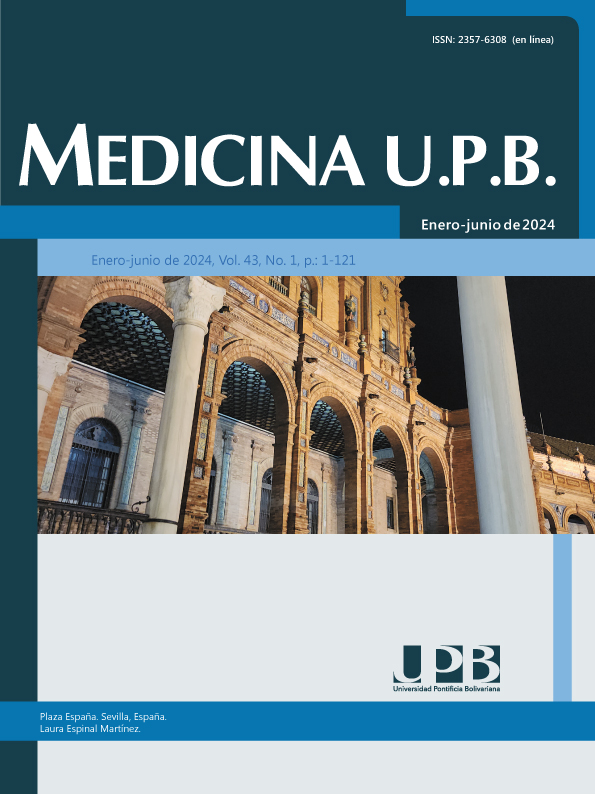Efectos de la mastectomía en los parámetros baropodométricos de pacientes con cáncer de seno
Contenido principal del artículo
Resumen
Objetivo: la mastectomía posterior al cáncer de seno produce diversas alteraciones posturales y biomecánicas en el plano frontal y sagital. Dichos cambios conducen a una cinemática alterada de la columna vertebral, desequilibrio muscular y alteración del soporte del peso del pie. Este estudio pretende describir las alteraciones de la baropodometría después de la mastectomía, con base en análisis baropodométricos de la presión media y la carga estática.
Metodología: se realizó un estudio descriptivo correlacional. Las propiedades de carga del pie se identificaron en 17 mujeres mastectomizadas. Se utilizó una placa de presión Ecosanit Foot para medir la carga del pie en posición anatómica y con los pies juntos.
Resultados: en el estudio participaron 17 mujeres mastectomizadas con una edad media de 54.16 años. Las pacientes reportaron una presión media significativamente mayor en la posición anatómica del lado dominante mastectomizado en comparación con el lado no dominante mastectomizado (227.2 ± 22.16 vs. 175.6 ± 14.95, p =0.05). No hubo diferencia significativa para la carga estática entre el lado dominante mastectomizado y el lado no dominante mastectomizado en la posición anatómica (52.43±4.069 vs. 49.69 ± 4.094, de forma respectiva).
Conclusión: los resultados actuales de nuestro estudio evidenciaron la distribución desequilibrada del peso (vector carga en el pie) en pacientes después de la mastectomía. Por tanto, en este texto se describen las alteraciones posturales, musculares, y el desequilibrio estático y dinámico en pacientes con cáncer de seno.
Referencias
Stout NL, Silver JK, Raj VS, Rowland J, Gerber L, Cheville A, et al. Towards a national initiative in cancer rehabilitation: Recommendations from a subject matter expert group. Arch Phys Med Rehabil. 2016;97(11):2006-15.
WHO. Global cancer observatory [Internet]. 2020 [citado 6 de mayo de 2021]. Disponible en:
ASCO. Breast cancer: Statistics [Internet]. 2021 [citado 6 de mayo de 2021]. Disponible en: https://www.cancer.net/cancer-types/breast-cancer/statistics#:~:text=The%20average%205%2Dyear%20survival,with%20breast%20cancer%20is%2099%25
Głowacka I, Nowikiewicz T, Hagner W, Nowacka K, Sowa M, Zegarski W. Sagittal plane postural changes in female patients with breast cancer after different surgical techniques. Breast J. 2017;23(1):109-11.
Malicka I, Barczyk K, Hanuszkiewicz J, Skolimowska B, Woźniewski M. Body posture of women after breast cancer treatment. Ortop Traumatol Rehabil. 2010;12(4):353-61.
Benton MJ, Schlairet MC. Upper extremity strength imbalance after mastectomy and the effect of resistance training. Sports Med Int Open. 2017;1(5):E160-5.
Zehra S, Doyle F, Barry M, Walsh S, Kell MR. Health-related quality of life following breast reconstruction compared to total mastectomy and breast-conserving surgery among breast cancer survivors: a systematic review and meta-analysis. Breast Cancer. 2020;27(4):534-66.
Liang Y, Xu B. Factors influencing utilization and satisfaction with external breast prosthesis in patients with mastectomy: A systematic review. International Journal of Nursing Sciences. 2015;2(2):218-24.
Hojan K, Manikowska F, Chen BPJ, Lin CC. The influence of an external breast prosthesis on the posture of women after mastectomy. J Back Musculoskelet Rehabil. 2016;29(2):337-42.
Lopera-Muñeton C, Valencia-Legarda F, Bedoya-Bedoya OM, Correa-Castaño D, Páramo- Velásquez CA. Body posture and biomechanics in women after mastectomy. J Phys: Conf Ser.
;1418:012009.
Głowacka-Mrotek I, Sowa M, Siedlecki Z, Nowikiewicz T, Hagner W, Zegarski W. Evaluation of changes to foot shape in females 5 years after mastectomy: a case-control study. Breast Cancer Res Treat. 2017;163(2):287-94.
Głowacka-Mrotek I, Sowa M, Nowikiewicz T, Siedlecki Z, Hagner W, Zegarski W. Foot posture
in female patients 5 years after breast-conserving surgery: a case–control study. Breast Cancer.
;25(3):325-33.
Manikowska F, Ozga-Majchrzak O, Hojan K. The weight of an external breast prosthesis as a factor for body balance in women who have undergone mastectomy. Homo. 2019;70(4):269-76.
Koralewska A, Domagalska-Szopa M, Łukowski R, Szopa A. Influence of the external breast prosthesis on the postural control of women who underwent mastectomy: Cross-sectional study. Front Oncol. 2022;12:920211.
Hojan K. Does the weight of an external breast prosthesis play an important role for women who undergone mastectomy? Rep Pract Oncol Radiother. 2020;25(4):574-8.
Jetha ZA, Gul RB, Lalani S. Women experiences of using external breast prosthesis after mastectomy. Asia Pac J Oncol Nurs. 2017;4(3):250-8.
Atanes AC, Dias MR, Yugo J, Filassi JR, Chada E, Alves E. Body posture after mastectomy: comparison between immediate breast reconstruction versus mastectomy alone. Physiother Res Int. 2017;22(1):34-43.
Ejaz A, Greenberger JS, Rubin PJ. Understanding the mechanism of radiation induced fibrosis and therapy options. Pharmacology & Therapeutics. 2019;204:107399.
Hsieh KL, Wood TA, An R, Trinh L, Sosnoff JJ. Gait and balance impairments in breast cancer survivors: A systematic review and meta-analysis of observational studies. Arch Rehabil Res Clin Transl. 2019;1(1-2):100001.
Lee DY, Seo SG, Kim EJ, Kim SJ, Lee KM, Choi IH. Inter-segmental motions of the foot in healthy adults: Gender difference. J Orthop Sci. 2016;21(6):804-9.
Davis AM, Galna B, Murphy AT, Williams CM, Haines TP. Effect of footwear on minimum foot clearance, heel slippage and spatiotemporal measures of gait in older women. Gait Posture. 2016;44:43-7.
Gomes FM, Santos KT, Silva SME, Pinho CPS, Silva A, Gomes FM, et al. Fragilidad en ancianos oncológicos en tratamiento con quimioterapia. Revista Chilena de Nutrición. 2019;46(4):384-91.
Campbell KL, Winters-Stone KM, Wiskemann J, May AM, Schwartz AL, Courneya KS, et al. Exercise guidelines for cancer survivors: Consensus statement from international multidisciplinary roundtable. Med Sci Sports Exerc. 2019;51(11):2375-90.
Stevens J, Burns E. CDC compendium of effective fall interventions: What works for communitydwelling older adults, 3rd Edition. Home and Recreational Safety, CDC Injury Center [Internet]. 2015 [citado 6 de mayo de 2021]. Disponible en: https://www.cdc.gov/homeandrecreationalsafety/falls/compendium.html
Guirguis-Blake JM, Michael YL, Perdue LA, Coppola EL, Beil TL, Thompson JH. Interventions to prevent falls in community-dwelling older adults: A systematic review for the U.S. preventive services task force [Internet]. Rockville (MD): Agency for Healthcare Research and Quality (US); 2018 [citado 6 de mayo de 2021]. Disponible en: http://www.ncbi.nlm.nih.gov/books/NBK525700/


